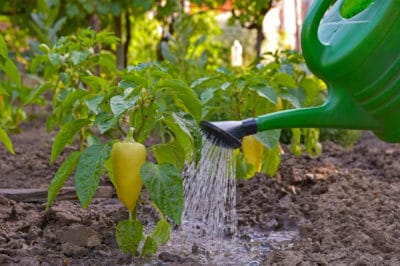Overwatering
Overwatering tends to be a larger problem than underwatering when it comes to pepper plants. Routine overwater can even lead to blossom end rot which will ruin fruits. Some gardeners stick to the rule of watering only when the plant shows signs of wilting. This is a useful guideline, but wilting can easily be caused by something other than dryness.
For that reason, it’s important to regularly check the soil. If a plant appears wilted, insert a finger into the soil around the roots. If it comes out dry, then go ahead and water. If there is moisture investigate other reasons why the plant could wilt like excess heat and sunlight or transplanting.
Watering Schedule
Having a watering schedule is important for maintaining an even moisture content. Peppers growing in pots will require more frequent watering than peppers in the ground. Warmer weather will evaporate more moisture, and all watering schedules should adjust with natural precipitation and season.
In the spring and fall plants may be watered one or two times a week while in the heat of summer they may require water twice a day.
Pepper Watering Tips:
- Peppers require 1-2 inches of water per week
- Water no less frequently than 3 times per week
- Use a moisture meter to alert you when plant is dry
Depth of Watering
If you spend the time to deeply and thoroughly water, you will need to water less frequently and the deepest roots of your plants will benefit. Keep in mind that wetter climate with short or cooler growing season may not benefit from deep watering.
The roots of pepper plants can extend 3 feet below the soil surface. It is recommended to water until the soil is wet 18 inches below the surface. soaker hoses and drip systems are the best ways to achieve this watering depth.
Methods of Watering
While overhead watering is a popular method, it isn’t always the healthiest or most effective. Pepper plants don’t like their foliage wet, and overhead sprinklers lose a lot of moisture to evaporation. Watering at the soil level is superior in many ways.
Drip irrigation conserves water, keeps soil evenly moist, and eliminates the need for you to remember a watering schedule. It also avoids creating areas of standing water where disease and insects can breed because you are never depositing large amounts of water on the soil at once.
